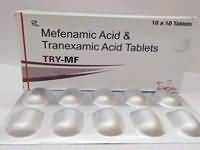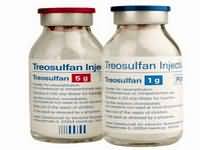Co trimoxazole

Co trimoxazole
CLINICAL USE
Antibacterial agent:Treatment and prophylaxis of Pneumocystis jiroveci pneumonia (PCP)Acute exacerbations of chronic bronchitis Urinary tract infections, on microbiological adviceDOSE IN NORMAL RENAL FUNCTION
PCP: 120 mg/kg/day in 2–4 divided doses Oral prophylaxis: 480–960 mg daily or 960 mg on alternate daysAcute exacerbations of chronic bronchitis and urinary tract infections on microbiological advice:IV: 960 mg – 1.44 g of co-trimoxazole twice a dayOral: 960 mg of co-trimoxazole twice a dayPHARMACOKINETICS
DOSE IN RENAL IMPAIRMENT
GFR (mL/MIN)
30–50 Dose as in normal renal function 15–30 50% of dose; PCP: 60 mg/kg twice daily for 3 days then 30 mg/kg twice daily<15 50% of dose; PCP: 30 mg/kg twice daily. (This should only be given if haemodialysis facilities are available)DOSE IN PATIENTS UNDERGOING RENAL REPLACEMENT THERAPIES
IMPORTANT DRUG INTERACTIONS
Potentially hazardous interactions with other drugsAnti-arrhythmics: increased risk of ventricular arrhythmias with amiodarone – avoid concomitant use; concentration of procainamide increasedAntibacterials: increased risk of crystalluria with methenamineAnticoagulants: effect of coumarins enhancedAnti-epileptics: antifolate effect and concentration of phenytoin increasedAntimalarials: increased risk of antifolate effect with pyrimethamineAntipsychotics: avoid concomitant use with clozapine, increased risk of agranulocytosisCiclosporin: increased risk of nephrotoxicity; possibly reduced ciclosporin levelsCytotoxics: increased risk of haematological toxicity with azathioprine and mercaptopurine. Antifolate effect of methotrexate increasedADMINISTRATION
Reconstition
–Route
IV, oralRate of Administration
Over 60–90 minutes Alternatively: 2–3 hours for high doses as undiluted solution via central line (unlicensed).Co-TriMoXAZoLE (TriMEThoPriM + sULFAMEThoXAZoLE) 191Comments
For anIV infusion
dilute each 5 mL co- trimoxazole strong solution with 125 mL sodium chloride 0.9% or glucose 5%Glaxo Smith Kline: dilute 5 mL to 75 mL glucose 5% and administer over 1 hour if fluid restrictedOTHER INFORMATION
Alternative dosing (for acute exacerbations of chronic bronchitis and urinary tract infections) on microbiological advice only; not PCPAfter 2–3 days, plasma samples collected 12 hours post dose should have levels of sulfamethoxazole not higher than 150 micrograms/mL. If higher, stop treatment until levels fall below 120 micrograms/mL. Plasma levels of trimethoprim should be 5 micrograms/mL or higher, for optimum efficacy for PCPFolic acid supplementation may be necessary during chronic therapy. Monthly blood counts advisable
See how to identify renal failure stages according to GFR calculation
See how to diagnose irreversible renal disease
Home








